-
Posts
14,343 -
Joined
-
Last visited
-
Days Won
25
Content Type
Profiles
Forums
Blogs
Gallery
Events
Store
Posts posted by Ed_Haynes
-
-
Military Unity Star, 1986
Awarded to commemorate the 15th anniversary of the confederation of the constituent emirates in 1971. Also described as the "1986 National Day Medal"?
Established: 1986? Manufactured by Spink of London.
Obverse: A 45-mm bronze star of dull and rather rough finish with ball points, resting on this a ten-pointed star, and, on this, a circle with the eagle of the U.A.E., surrounded by a wreath. Suspended by a straight bar suspender bearing the dates "1971-1986" (C.E.).
Reverse: Much like the obverse, but in the center circle the number "15" within a circle of seven linked hands, representing the unification of the seven constituent emirates. On the reverse suspension bar, "Al-Amadat Al-Arabiya Al-Matahadat" or "The United Arab Emirates".
Ribbon: 31 mm, red with 2-mm edge stripes (reading inward) of green and white and a 2-mm central black stripe; 2 mm green, 2 mm white, 10.5 mm red, 2 mm black, 10.5 mm red, 2 mm white, 2 mm green.
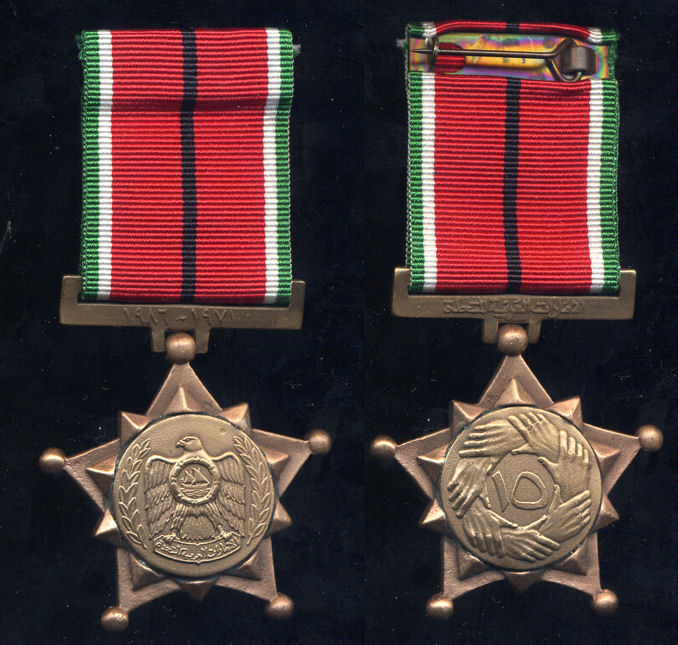

 1
1 -
1976-78 Lebanese Peacekeeping Medal
Ribbon: Stripes (left to right) of black, medium white, green, red, green, medium white, black.
Another naked medal, sorry.
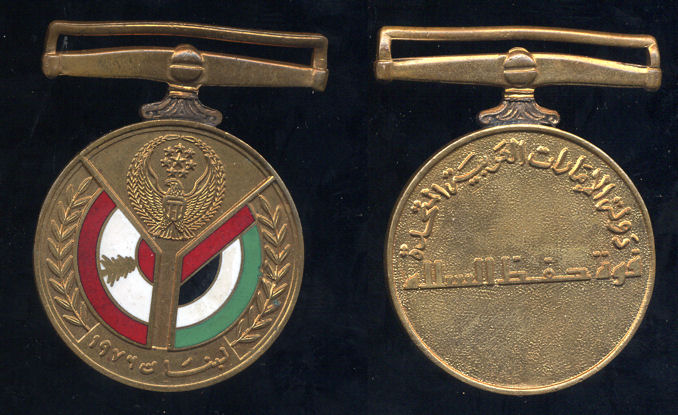

 1
1 -
ABU DHABI: Defence Forces Service Medal, 1966-76
Apologies for the naked medal.
There is also one in a Pakistani group at http://gmic.co.uk/index.php?showtopic=2452&st=1.
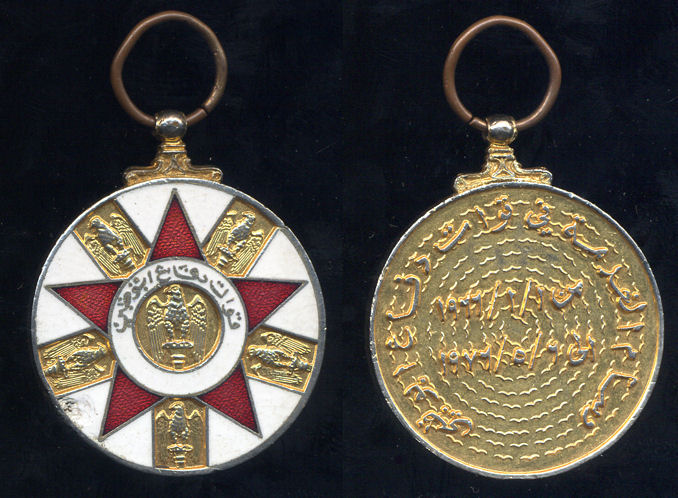

 1
1 -
The phaleristic (and political) history of the UAE is made more complex by virtue of the fact that it is a loose confederation of seven States. The United Arab Emirates was established on 2 December 1971 through the confederation of seven coastal, previously semi-independent, British-protected emirates: Abu Dhabi, Dubai, Sharjah, Ajman, Uum al-Qaywayn, Ras al-Khaimah (joining the federation only in 1972), and Fujairah. Each of these have their own awards, as does the UAE.
Sources are very thin. See:
http://faculty.winthrop.edu/haynese/medals/uae.html
http://www.medals.org.uk/abu-dhabi/abu-dhabi.htm
http://www.coleccionesmilitares.com/cintas/cintasas.htm#e (click on "EMIRATOS ?RABES UNIDOS" and "VARIOS")
0 -
Never seen any other classes than this, so assume it is third.
0 -
Wisam al-Tahrir / Liberation Medal
Awarded for service in the liberation of Kuwait between 2 August 1990 and 31 August 1993. The award is often referred to as the "Order of Liberation". The service area included the Arabian Gulf, Red Sea, Gulf of Oman, Gulf of Aden, and that portion of the Arabian Sea north of 10?N and west of 68?E, as well as the land area of Iraq, Kuwait, Saudi Arabia, Oman, Bahrain, Qatar, and the United Arab Emirates. Qualifying service was one day of service on the ground or on a ship or aircraft directly supporting military operations; temporary duty of thirty consecutive days or of sixty non-consecutive days also qualified for the medal. Due to the short notice, Kuwaiti opposition to the Iraqi invasion on 2 August was limited. Some 7000 soldiers escaped to Saudi Arabia, with the remainder being killed, captured, or integrated into the Kuwaiti resistance movements against Iraqi occupation forces. In Saudi Arabia, the refugee Kuwait troops organized their role in the reconquest of their homeland. This award was commonly awarded to allied forces in the struggle to liberate Kuwait. The medal in the third class was most commonly awarded to British participants. Participants from the United States of America, however, confronted great issues of policy regarding the award and received the fifth class. (These are illustrated below, class by class.) Given the tremendous flexibility of the word wisam, this has sometimeds been described as the "Order" of Liberation; I have adopted here the translation of wisam as "medal," as it seems more appropriate for the nature of the award and the service.
Established: Manufactured by Spink & Son (London, England) and by Bertoni (Milan, Italy).
Obverse: The description varies by class, and is detailed below.
Reverse: The description varies by class, and is detailed below.
Ribbon: Pattern of Kuwait flag: equal stripes of red/white/green, at the top a black trapezoid.
Awards: As far as can be determined, the following Kuwaiti participation can be traced: Kuwaiti Division: 35th Armoured Brigade ("Martyr Brigade"), 15th Infantry Mechanized Brigade, __ Mechanized Brigade ("Liberation Brigade," part of the Saudi I Corps); contingent in the G.C.C. "Peninsula Shield" force; helicopter detachment; 1 squadron fighter-bombers; 1 squadron ground attack aircraft. In total, an estimated 9,643 Kuwaiti front-line troops participated in the war and one Kuwaiti serviceman was killed and 7 were wounded. One aircraft was lost. The medal was also widely awarded to other nations' forces in the "coalition" which liberated Kuwait. Although many (most?) declined the multi-class award; for example, the United States authorized only 5th class awards, while British troops received, but were not authorized to wear, the 3rd class.
- first class - A five-pointed red-enameled star with a wreath of olive leaves, the whole on a series of rays; the center is white-enameled with the Arabic inscription "Kuwait Armed Forces" and the enameled crest of Kuwait. It is suspended from a doubled ribbon, presumably around the neck. Awarded to officers of the rank of lieutenant-general or general (equivalent of US O-9 and O-10). The overall design is similar to the Order of National Defense. See http://www.omsa.org/photopost/showphoto.ph...ze=big&cat= at the OMSA website.
- second class - A five-pointed gilt star with a wreath of olive leaves between the points; in the center, the enameled national crest of Kuwait and the Arabic inscription "Kuwait Armed Forces". A device of the Kuwaiti crest is worn on the suspension ribbon. Awarded to officers of the rank of brigadier-general or major-general (equivalent of US O-7 and O-8). See http://www.omsa.org/photopost/showphoto.ph...ze=big&cat= as the OMSA website.
- third class - A modified five-pointed bronze-gilt star with a circular rim connecting the points, and the enameled crest of Kuwait in the center. Awarded to officers of the rank of major, lieutenant-colonel, and colonel (equivalent of US O-4, O-5, an O-6). This class was adopted for general award to British troops. See http://www.omsa.org/photopost/showphoto.ph...ze=big&cat= at the OMSA website.
- fourth class - A circular silver medal, with rays emanating from the center and a five-pointed star with the enameled crest of Kuwait in the center. Awarded to warrant officers and commissioned officers below the rank of captain (equivalent ranks ranging from US W-1 to O-3). See http://www.omsa.org/photopost/showphoto.ph...81&size=big at teh OMSA website.
- fifth class - A circular bronze medal with the crest of Kuwait with enemaled arms, above the Arabic inscription "Wisam al-Tahrir 1991" or "Liberation Medal 1991". The reverse shows a map of Kuwait with rays behind. Awarded to enlisted men (equivalent to U.S. E-1 to E-9). This class was adopted for general award to U.S. troops. Shown below (US Graco manufacture, ribbon slightly askew).
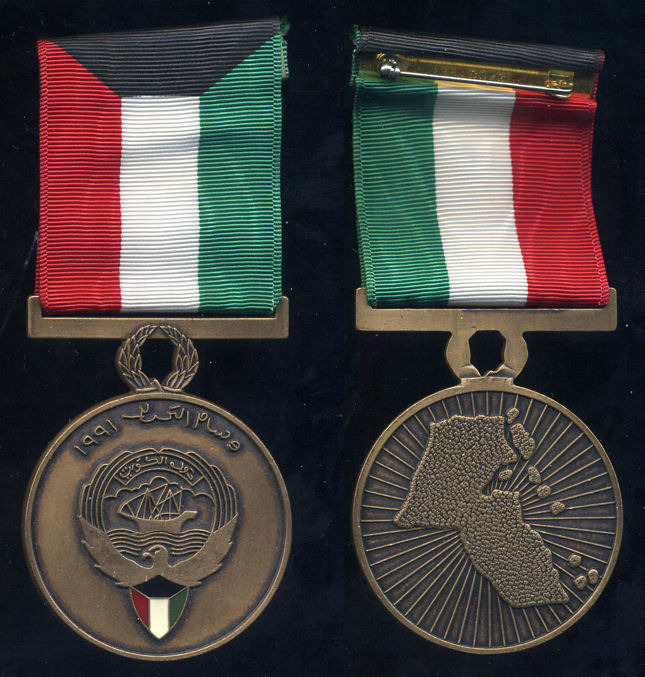
 0
0 -
And the silver and bronze classes.

 0
0 -
Military Service Medal
Granted to military, police, or civilian personnel who performed their duty in a distinguished manner.
Established: Established by Law No. 17 of 1962. Manufactured by Spink and Son (London England).
Obverse: A circular 42 mm medal, the composition of which varies by class (and this is detailed below). A map of Kuwait with the Arabic inscription "Kuwait". Below this, the legend "The Medal for Military Service". The whole obverse is surrounded by a wreath. The medal is suspended by a ring suspender.
Reverse: A three-line Arabic inscription "Established by Law No. 17 of the Year 1962".
Ribbon: 39 mm, the colors differ by class (and these are detailed below), but the overall impression is a ribbon with two pairs of stripes toward each edge: 2 mm color, 1 mm stripe, 2 mm color, 1 mm stripe, 26 mm color, 1 mm stripe, 2 mm color, 1 mm stripe, 2 mm color. Stars are worn on the ribbons in metal matching the color of the medal.
- gold, with gold star on ribbon - black ribbon with metallic gold stripes (shown below)
- silver, with silver star on ribbon - light blue ribbon with metallic silver stripes
- bronze, with bronze star on ribbon - brown with yellow stripes (often encounted without the ribbon star?)
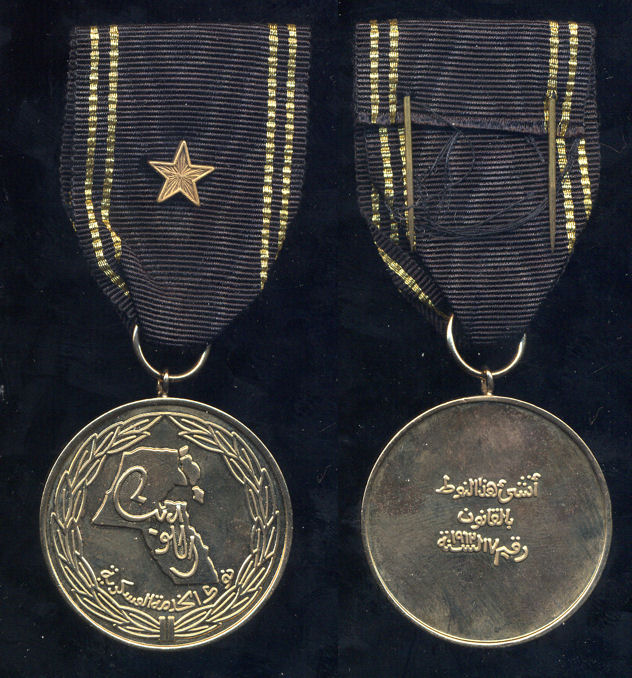
 0
0 -
There aren't many good sources out there.
http://faculty.winthrop.edu/haynese/medals/kuwait.html
http://www.omsa.org/photopost/showgallery.php?cat=561
http://www.medals.org.uk/kuwait/kuwait.htm (though not much there)
0 -
It is interesting, by the way, how little information is available about Mexican decorations. It is a big, well-developed country in North America, with a well-known language, and the resources in comparison to USA or Canada are less than modest. Don't know why.
So true. So sad.
Maybe we, in this forum, can do better?
Please.
0 -
Medal of Merit
This is what it is usually called. Information is IMMENSELY elusive.

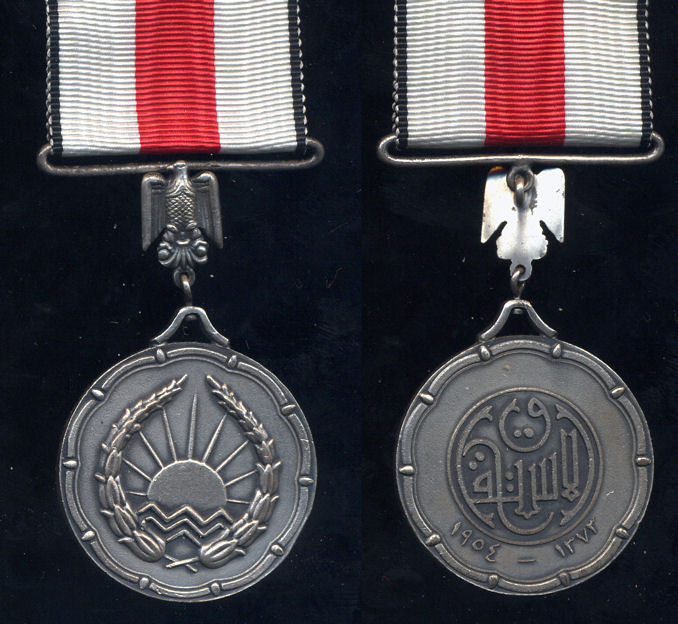
 1
1 -
Dix, Noonan, Webb. The major UK phaleristic auction house. Their web site is nicer because you can easily search past sales!
0 -
Good Conduct Medal -- Prototype
A rejected prototype for the Good Conduct Medal. Ribbon (badly faded on obverse) is medium blue with a red-pink center stripe.
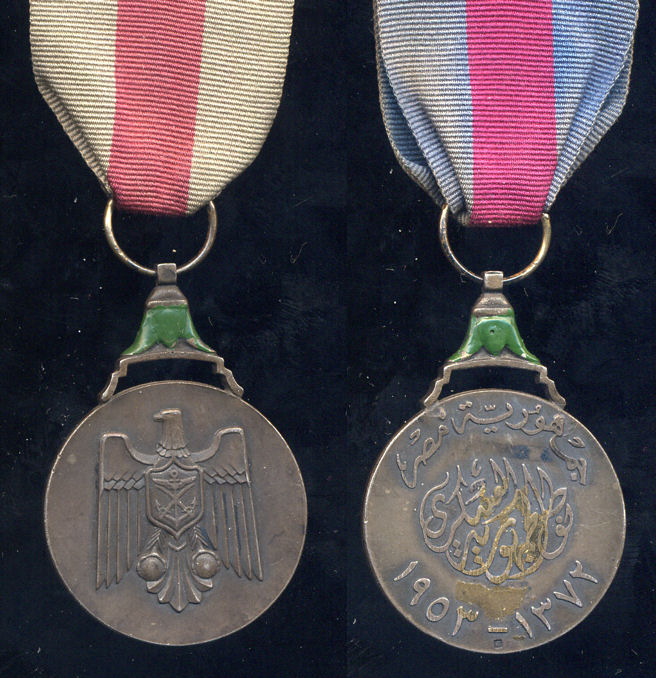
 1
1 -
Good Conduct Medal
Not much is known.
Ribbon: Bright blue with a broad center stripe of pale yellow-orange.
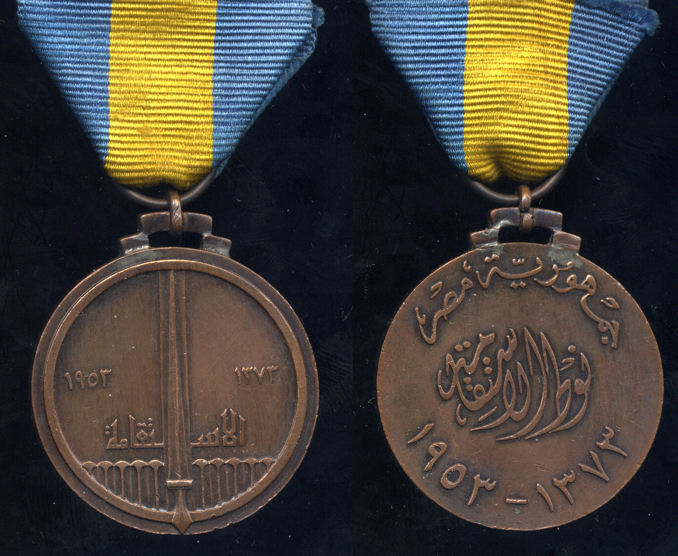
 1
1 -
Order of Sports
Established to reward Egyptians and foreigners for their contributions to athletics in Egypt and in international (especially Olympic) competition.
Established: Established by Law No. 528 of 1952 and revised by Law No. 12 of 1972. Known to have been manufactured by Bichay (Cairo, Egypt).
Obverse: A silver-gilt ten-pointed faceted star, with a gold, green-enameled, ball-tipped five-pointed star on it. The star is on a green and white circular background with a series of five interlinked rings between each point of the star (recalling the Olympic emblem). The star has a torch on each point, flame toward the center and a red central medallion with the name of the order (in Arabic) in gold "Sports". Suspended by a bar of five interlinked Olympic rings.
Reverse: Plain.
Ribbon: White with apple-green edges.
- first class - 65-mm neck badge on a 37-mm ribbon
- second class - 55-mm breast badge on 37-mm ribbon with 23-mm rosette
- third class - 45-mm breast badge on 37-mm ribbon (shown below)
I apologize. This is a hard one to scan. It is HEAVILY valuted and the suspending Olympic rings tend to flip over on scanning. This spoils the visual impression. Time to drag out the camera?
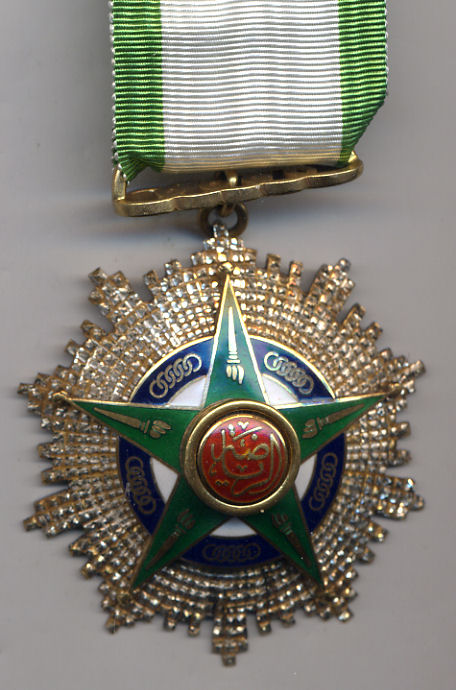
 1
1 -
John Spratt (D-SC) is one I have spoken with who "gets it". I have written him but have not heard back. The next time he's back in the district, I'll be meeting with him. He has some clout these days.
0 -
While I must admit I am not overly fond of miniatures, this is a cute little one, and one I could not pass up. (Especially as a gift from the delightful shop-owner, a wise man now missed by many.)
Medal for Devotion to Duty-
Awarded for good services to the State, both civil and military.
Established: By King Ahmad Fuad I in 1920 and modified by Royal Order No. 9 of 1923 and Royal Order No. 23 of 1930.
Obverse: The state coat of arms, with the date "1337" or "1337 [A.H.]" above. Surrounded by an Arabic inscription. Suspended from a broad plain straight-bar suspender.
Reverse: Arabic inscription.
Ribbon: The original (pre-1953) ribbon is 1-3/8" medium blue moir?. This ribbon is continued with the Medal of Civic Duty after the Revolution.
- gold (miniature shown)
- silver
- bronze
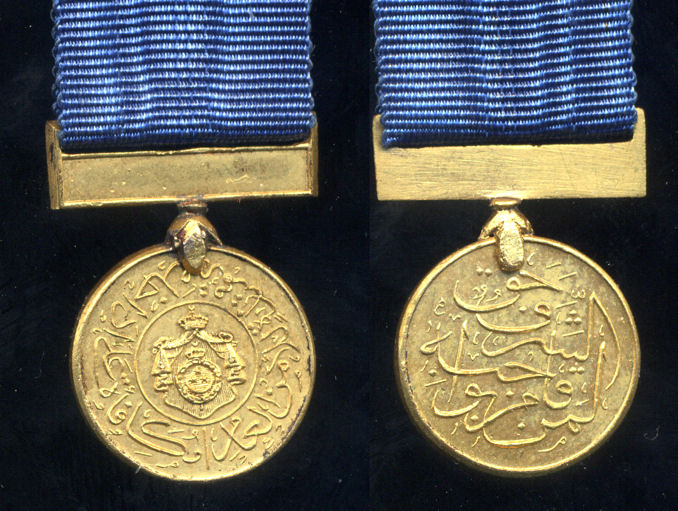
 1
1 -
Dont forget though all property is theft

Comrade Vic
Not collectively owned property, comrade, for it is now owned by the immoral misappropriation if the labor of others. This is no simple bourgeois property!
(Yes, I have been re-reading the Manifesto!)
0 -
Can you give a non-reflective scan of the DFC. What is the date?
For value, I'd check what similar groups (with documents) have gone for at DNW recently.
A nice one.
0 -
Christian,
Who is talking about "property" in a "communist" forum ?



Cheers.
Ch.
Yes, comrade. Property of the workers. Them's us.
0 -
Order of Devotion
Awarded to all members of the armed forces and to civil servants for extraordinary courage and loyalty, for the performaance of services on behalf of the homeland, or for at least five years of sincere and faithful service. The award may also be presented to foreigners. Normally, the initial appointment will be to the lowest class, with successive appointments by promotion to the higher grades. When awarded for bravery, the badge is surrounded by a wreath of oak leaves (???). Also referred to as the "Order of Loyalty" or the "Loyalty Medal".
Established: By Legislative Decree No. 163 of 4 July 1953.
Obverse: A five-pointed star edged black and with an enameled light green design in the center, all within a wreath (for awards for bravery only). The size of the badge varies by class, as detailed below. In the center, there is an Arabic inscription in black: "Honor and Devotion". The medal is either worn as a neck badge or suspended from an integral straight-bar suspender.
Reverse: A raised horizontal diamond with the Arabic abbreviation for "Syrian Republic"
Ribbon: Equal stripes of black, white, and dark green, left to right. Various devices are worn on the ribbon to indicate the class.
--- with wreath for bravery:
- first class - also termed Excellent Class - a ??-mm neck badge in silver with wreath
- second class - also termed First Class - a ??-mm neck badge in silver with wreath
- third class - also termed Second Class - a 41-mm silver breast badge with wreath and an oal leaf on the ribbon
- fourth class - also termed Third Class - a ??-mm silver breast badge with wreath
- fifth class - also termed Fourth Class - a ??-mm bronze breast badge with wreath
--- without wreath for distinguished service:
- first class - also termed Excellent Class - a ??-mm neck badge in silver
- second class - also termed First Class - a ??-mm neck badge in silver
- third class - also termed Second Class - a 41-mm silver breast badge with a bronze oak leaf on the ribbon
- fourth class - also termed Third Class - a ??-mm silver breast badge
- fifth class - also termed Fourth Class - a 39-mm bronze breast badge (shown below, sorry it is naked)
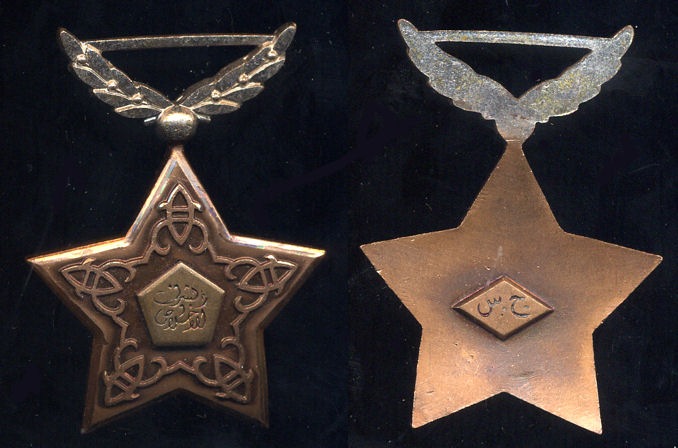

 1
1 -
6th October Medal
Awarded for Syrian participation in the October/Ramadan/Yom Kippur War with Israel of 6-24 October 1973. The medal was also awarded to civilians and foreign nationals who contributed to Syria's war effort. This was a very costly war for Syria, representing some 7,000 troops killed and 21,000 wounded; 600 tanks were lost, 165 fighter aircraft were destroyed, and 7 ships were sunk. Moreover, Syria lost 845 km2 of territory.
Established: By Legislative Decree No. 19 of 15 February 1974.
Obverse: A 44-mm bronze five-pointed rayed star, with floreate designs between the rays. In the center, a circular medallion, enameled white, with a dark-enameled map of the Arab world in the center. Suspended by an ornate trophy of arms and Syrian eagle.
Reverse: The Arabic legend "Medal of 6th October".
Ribbon: Red, with a 4 mm white center stripe edged by 4 mm black stripes. Awards: Five Syrian divisions, comprising some 45,000 men, participated in the war.
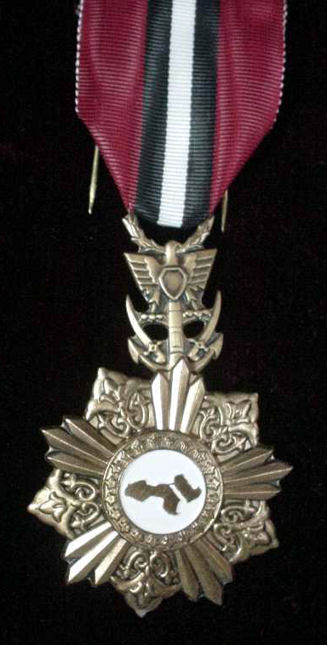

 1
1 -
Army Silver Jubilee Medal
Awarded to all members of the armed forces who were serving on 1 August 1971 to commemorate the 25th anniversary of the establishment of the Syrian Arab Army in 1946 (1945?).
Established: By Legislative Decree No. 1589 of 28 July 1971.
Obverse: An ornate 50-mm four-pointed silver-gilt ornate star with diagonal crossed spears. In the center, within a green-enameled wreath, a red-enameled circle with a gilt Iraqi eagle with an upright sliver sword behind and the Iraqi arms, properly enameled, on its breast. Below the shield, on a silver scroll, the Arabic legend "Namin / al-Bish / al-Radari" and, at the botton on a silver scroll "1971 - 8 - 1" or "1.8.1971". Above all, the legend "Nadkari al-Manamasah / Zaashrun" or "25th Anniversary of Creating the Syrian Arab Army" (???). Suspended from the ribbon by a ring.
Reverse: Plain.
Ribbon: 36 mm, rose-pink with narrow edge stripes (reading inward) of 2 mm yellow and 2? mm purple. A sliver (lightly silvered bronze?) star (meaning unknown) is frequently seen on the ribbon.


 1
1 -
Order of Military Merit
Awarded to members of the armed forces for bravery in battle or for overall efficiency in combat. It may also be awarded to civic entitles, such as towns or factories, for contributions to military enterprises. Also seen referred to as the "Military Medal", the "Order of the War Crescent" and - very confusingly - as the "Medal of Courage".
Established: By Legislative Decree No. 167 of 4 July 1953.
Obverse: A 43 mm bronze eight-pointed rayed star, with the star-points the breeches of cannons. The center has a five-pointed star and crescent. The medal is surmounted by a large eagle, with wings fully spread (and a wingspread of 44 mm). Suspended by a loop attached to the back of the eagle's wings. The same badge is worn for each class and only the ribbon appurtenances differ.
Reverse: Plain.
Ribbon: Basically, 38 mm medium red with two 3 mm white stripes toward each edge and very thin black threads edging the white stripes; 3 mm white, 3 mm red, 3 mm white, 3 mm white, 20 mm red, 3 mm white, 3 mm red, 3 mm white. Different ribbon appurtenances are worn for each class, as outlined below; the medal is, however, often encountered without these ribbon devices.
- first class - also termed Excellent Class - ribbon has a red and white rosette mounted on a silver (?) plaque is worn on the ribbon
- second class - also termed First Class - the ribbon has a gold (?) plaque to the rosette
- third class - also termed Second Class - the ribbon has a palm leaf
- fourth class - also termed Third Class - the ribbon has a gold star
- fifth class - also termed Fourth Class - the ribbon is plain, without devices (shown below)
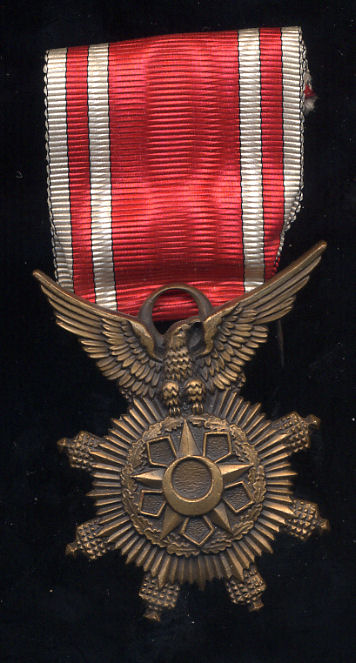

 1
1




ARAB MEDALS -- United Arab Emirates
in Middle East & Arab States
Posted
Liberation of Kuwait, 1991
Awarded to U.A.E. troops which participated in the campaigns to liberate Kuwait in Gulf War II. The Emirates was the first Gulf state to propose combined military action to achieve the departure of Iraqi troops from Kuwait. Ultimately, Emirati troops participated in the liberation of Kuwait City.
Obverse: Gilt circular medal, 38 mm. Outline map of Kuwait with prominent rays behind. At the lower left the arms of the U.A.E. with the crest on the eagle's chest enemeled. Suspended by a ring.
Reverse: Three-line inscription.
Ribbon: 40 mm, nine (essentially) equal stripes: black, yellow, gre*en, white, red, white, green, yellow, black. Black 5 mm, yellow 4 mm, green 4 mm, white 4 mm, red 6 mm, white 4 mm, green 4 mm, yellow 4 mm, black 5 mm.
Awards: As far as can be determined, the following Emirati participation can be traced: ground and air contingent in the G.C.C. "Peninsula Shield" force. In total, an estimated 1,497 Emiratian troops served in the war, of whom 6 were killed. None were recorded as wounded in combat.